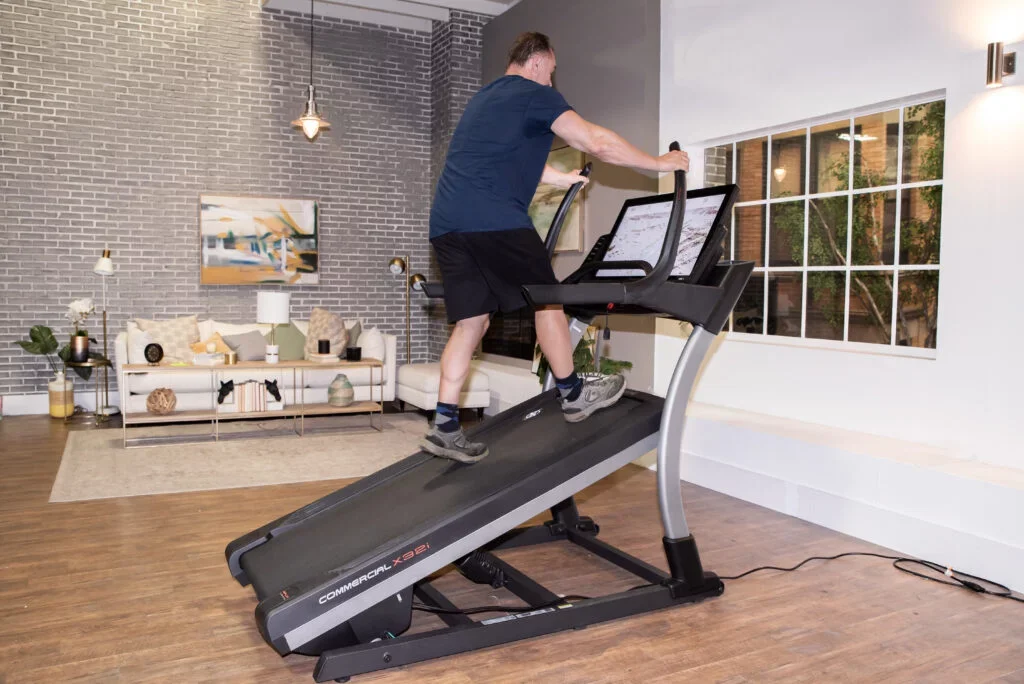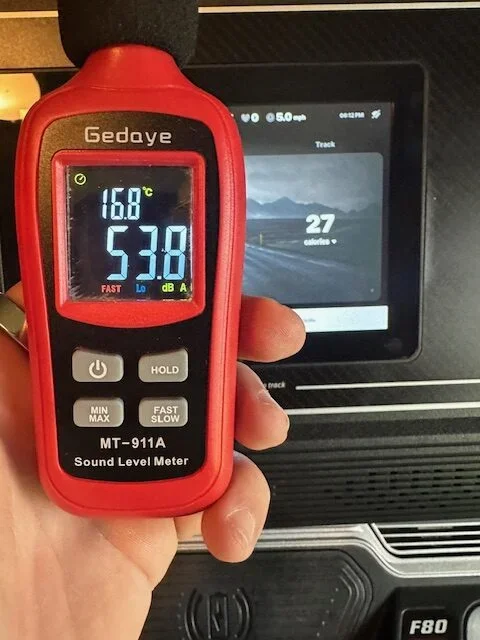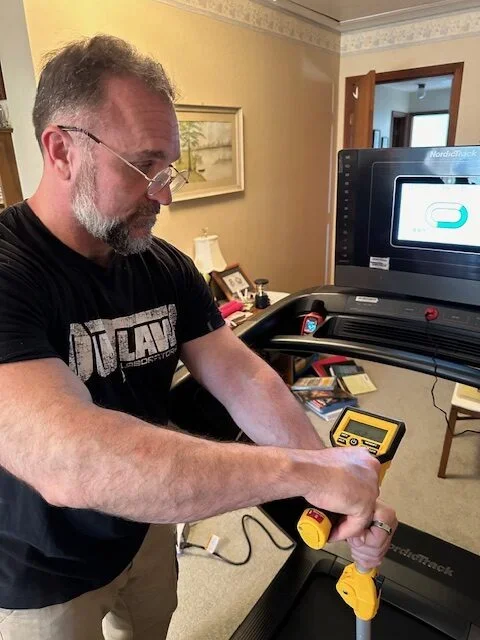Have you ever wondered what goes into testing a treadmill? You’re not alone. In addition to jumping aboard, we like to dive into the nuts and bolts. Read below to learn more about, particularly if you’re in the market for a new treadmill. You can read up on our Five Step Treadmill Buying Guide for reference. Whether you’re looking for a simple folding unit, or a high-priced model suitable for heavier users, knowledge is power and the more you have the better.

Armed with my handy treadmill-testing kit, I can easily test elements of a treadmill like incline and decline. Photo by Brian Boyce
Testing Treadmills With Common Tools
One of the things we do at TreadmillReviews.net is test the machines themselves to make sure they match up with the manufacturers’ specifications. In addition to a Zozen Collapsible Measuring Wheel, Gedave Sound Level Meter, Kuman Power Meter, I also have an Inkuen Digital Level with a bubble vial. These are all common tools you could buy at a hardware store, or online at Amazon.com or Walmart.com. As a rule, I have to say most treadmills purchased from reputable manufacturers are going to be in line with the specifications, but there are a few quirks I’ve learned over the years. And one of these quirks involves a treadmill’s levels.
When shopping for treadmills and considering their incline and decline, be sure to note whether they use the term “percent” or “level.” Here’s the deal, a treadmill could have 100 levels contained with a range of 0-12%, depending on how they define each level. To that extent, when a manufacturer advertises its treadmill as having a -3% decline, remember that can sometimes be from the rear up. What this means is that the head of the deck may be at 1% and the rear may be elevated upwards of 3-4%. But where you’re taking your strides along the deck will matter, if you’re going to be picky about it, which we here at TreadmillReviews.net tend to be.

This is a picture of the NordicTrack Commercial 1750’s deck toward the front at -3% decline. Photos by Brian Boyce

This is a picture of the NordicTrack Commercial 1750’s deck toward the rear at -3% decline.

The Sole F80 offers 15 different levels of incline which cap out at a little over 12%.

I checked the incline and decline of the NordicTrack1250 using this digital level and found it matched up to the manufacturers’ specs. You’ll see here the unit at full tilt, 12%.
Why Treadmill Incline Matters
Simply put, there’s no easier way to increase the intensity of your treadmill workout than to manipulate the incline. I can leave the actual speed of the machine at the same rate and watch my heart rate climb while adjusting the elevation of the deck. And this isn’t just my own experience, it’s a well-documented phenomenon tested in labs. Consider the conclusions reached by authors of “Effect of Uphill Running on VO2, Heart Rate and Lactate Accumulation on Lower Body Positive Pressure Treadmills” published in the journal Sports. Using a sample of 10 well-trained runners on treadmills, they found that both oxygen consumption and heart rate were significantly affected by inclines, particularly those around the 7% level. But let’s face it, you really don’t have to read too many studies to figure this out. Doctors have been manipulating treadmill incline as a means to stress test heart patients for years.
So as a customer, you want to know that the treadmill you’re getting is as good as the guarantee. In my own experience, I’ll tell you that consistency rules the day. As you can see from the pictures I’ve taken above on three different treadmills in my own home, there’s can be a good bit of variance in these units depending on whether they advertise the incline in terms of “levels” or “percentage,” and where on the deck you place the level. But as long as you’re using the same treadmill consistently, then the affect of the incline manipulation will ultimately work. To me, this is just like the stacked cable-pulley strength machines in a gym. Just how many pounds of resistance is generated per plate depends a lot on the engineering of the pulleys and the angle when in use.
So, when I say “consistency rules the day,” one thing I check for is to see if the treadmill hits the same incline percentage multiple times at the same level. If I adjust the treadmill to a Level 5 incline five times in a row, does it go to the same percentage point on my digital level each time? If it does, I’m pretty happy with it. My greater concern would be if the treadmill was 6% at Level 5 one time, 3% another, then perhaps 7%. That would be a problem, and frankly I have yet to see that.
During the course of your treadmill ownership, this might come into question for you if there are problems with the motor. You might also want to use a level when aligning, adjusting, or replacing a belt on a treadmill.
Reasons to Adjust Your Treadmill Incline
Starting with a few perks of incline running:
- Boosts Heart Rate: Just like walking up a flight of steps can tucker you out, so can adjusting the incline of your treadmill.
- Boosts Oxygen Consumption: If you’re looking to improve overall health, there’s no question the science supports the idea that incline training can help your aerobic conditioning.
- Activates More Muscles: If you’re looking to add strength to your cardio workout, keep in mind that incline training activates more muslces in the quads and hamstrings than flat level running and walking.
- Results in Greater Fat Loss: By spiking your metabolism and heart rate, you’re burning more calories per session than a flat-level movement, and this results in more calories burned.
- More Fun: Jogging in place can get borning. Adjusting the incline spices things up a bit.
- Great Interactive Programming: If you enjoy workout apps like iFit or Echelon Fit, there are tons of programs for hill climbs and mountain jogs.
There’s a reason so many treadmills offer incline and decline these days. Most people can’t imagine a treadmill without some option here. In my experience, the range of incline depends a bit on the price, but the average tends to be upwards of 12%.
What Treadmills Feature Incline
Most of your better treadmills on the market these days feature some kind of incline. But a few that stand out include:
If you’re into incline training, there’s no question the NordicTrack X22i brings it hard-core. With an award-winning 40% incline and -6% decline, as well as a gigantic 22″ high-definition touchscreen, it really does feel like you’re hiking up the Blue Ridge Mountains when you’re using the iFit program. On sale this spring for $2,999, down from $3,499, it’s a big, non-folding treadmill. Measuring 70″ x 39″ x 72.5″ at an in-box product weight of 417 pounds, I see why NordicTrack placed a 4.0 CHP motor inside to guarantee a 400-pound user maximum. You can read my full review of this treadmill here.

The NordicTrack Commercial X22i ramps up to 40%. Photo by: Oleksandr Kosheliev / TreadmilReviews.net
If bigger is better, then the NordicTrack X32i brings the same 40% incline and -6% decline as its smaller sibling, but with this model comes a 32″ high-definition touchscreen. Priced at $4,499, it’s a whopper in every respect, true. But you’ll definitely feel like you’re surrounded by the mountains in which you run on this. Powered by a 4.25 CHP motor, this unit measures 76.5″ x 40″ x 73″ and weighs 462 pounds in-box. Given the size, no, it doesn’t fold, but it does support up to 400 pounds in user weight. You can read my full review here.

TreadmillReviews editor Brian Boyce maxes out a 40% incline. Photo by: Oleksandr Kosheliev / TreadmilReviews.net
For those seeking a more budget-friendly treadmill, the Sole F80 is always a solid choice. With up to 15 levels of incline, the machine sports a 3.5 CHP motor and measures 86″ x 39″ x 66″ with a user weight maximum of 350 pounds. Priced at $1,899, the machine comes with 10 built-in workouts. You can read my full review here.

The Sole F80 has up to 15 levels. Photo by Brian Boyce
Why Testing Treadmill Noise Matters
When I use a Gedave Sound Level Meter to test a treadmill’s noise level, I can tell right off the bat this is a variable metric. If I’m on the treadmill while the sound meter is on, the noise of my own feet clomping atop the deck will often be louder than the motor. But treadmill noise is one of the first things people ask when shopping for a treadmill. If you’re going to place this inside your own home and perhaps you have roommates, you’ll not want to disturb them while jogging. And the same is true for apartments.
In case you’re into trivia, the decibel (dB) is a unit which measures the ratio of power on a logarithmic scale. The decibel is used to measure the level of intensity, acoustic waves, and electric signals. One decibel is one-tenth (1/10) of one “bel,” which is a unit named for the inventory Alexander Graham Bell. The fact that decibels are logarithmic means they don’t remain steady but rather fluctuate. As a rule, sounds measuring over 70 decibels are considered unsafe, and those over 85 can cause damage if suffered for long periods of time. Consider the following approximations:
- 30 decibels: Whispers, soft music
- 40 decibels: A babbling brook
- 50 decibels: Light traffic, refrigerator
- 60 decibels: Conversational speech, air conditioner
- 70 decibels: Shower, dishwasher
- 75 decibels: Vacuum cleaner
- 80 decibels: Alarm clock, garbage disposal
- 90 decibels: Lawnmower, squeeze toy
What I do when testing noise levels of treadmills is set the meter in the accessory tray and check out the decibels at various speeds, and then check it when I myself am on top of it.

The Sole F80 is a relatively quiet treadmill. Here I’m measuring the sound as it moves from 5 to 6 miles per hour. Photo by Brian Boyce
Most treadmills I’ve measured run around the 50 dB mark at the 5 to 6 mile per hour mark. Obviously this doesn’t include workout music or, the sound of your own feet on the deck. I’ve found that will vary more by the person’s bodyweight then the treadmill itself, as a 250-pound user will produce more noise than a 150-pound individual. Cheaper, lighter-framed treadmills also tend to be louder than those with more sturdy frames and larger motors, such as those above 3.5 CHP.
Why Testing Distance Sensors Matters
Another thing I look for when testing treadmill is consistency of the distance sensors. When I use a Zozen Collapsible Measuring Wheel I set the wheel on the treadmill and let the belt run. Ultimately what I’m looking for here is consistency. Everyone’s stride is a bit different, and so just because you set the unit at 5 miles per hour doesn’t mean you yourself will travel that far in one hour if your steps are shorter than the average person. And the same is true with taller people and longer strides. When using the distance wheel though I can tell whether a treadmill’s motor is consistent and continuous in how it runs. I’d be more concerned if there were variance between the distances shown at the same speed. For example, if I run the wheel five different times at 5 miles per hour, I expect to see the same basic rate. And to that degree, I have yet to see where that’s not the case. As a user of treadmills, I’d say consistency is more important in monitoring your own individual progress, just like heart rate.

The NordicTrack 1250 has a relatively accurate distance tracker. Photo by Brian Boyce
Works Cited
- Effect of Uphill Running on VO2, Heart Rate and Lactate Accumulation on Lower Body Positive Pressure Treadmills. Sports. 9(4)51.
